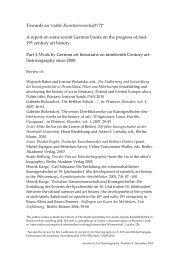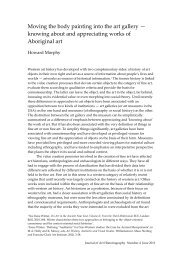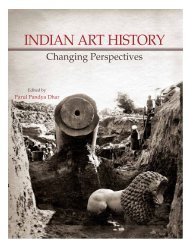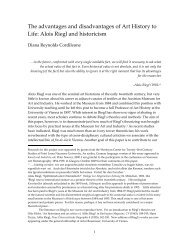9/CCG1 - Journal of Art Historiography
9/CCG1 - Journal of Art Historiography
9/CCG1 - Journal of Art Historiography
You also want an ePaper? Increase the reach of your titles
YUMPU automatically turns print PDFs into web optimized ePapers that Google loves.
Carolyn C. Guile<br />
Winckelmann in Poland: An Eighteenth-Century<br />
Response to the ‘History <strong>of</strong> the <strong>Art</strong> <strong>of</strong> Antiquity’<br />
writings <strong>of</strong> the Commonwealth's thinkers c.1800-1815. Unable simply to accept the<br />
status quo, Potocki and others seemed to embrace one <strong>of</strong> two positions: the nation<br />
could either cleave to a sense <strong>of</strong> its former political greatness, or re-examine itself<br />
and reconstruct its cultural relevance and place within European tradition. His text,<br />
‘Thoughts on the General Reform <strong>of</strong> the Government <strong>of</strong> Poland’ written in 1789,<br />
just prior to the Second and Third Partitions, drew on the Commonwealth’s political<br />
failures <strong>of</strong> the preceding decade as a means <strong>of</strong> warning the citizenry dangers <strong>of</strong> a<br />
system too vulnerable to take-over by foreign powers. 6 Notably, they chose to<br />
perform this post-mortem through arts and letters. In effect, the Commonwealth<br />
would become a state <strong>of</strong> mind, in the absence <strong>of</strong> statehood. 7<br />
The conflicting positions taken by two friends, intellectuals and co-founders<br />
<strong>of</strong> the Society <strong>of</strong> the Friends <strong>of</strong> Learning are instructive; each conceived <strong>of</strong> the road<br />
to restoration in an entirely different way. According to Potocki, 9 the Poles should<br />
examine their past, present and future in terms shared by their European neighbors,<br />
with whom they could identify common values and from whom could be taken the<br />
historical lessons revealed in the cyclical models <strong>of</strong> rise and decline. For Potocki, the<br />
history <strong>of</strong> ancient art could <strong>of</strong>fer a utilitarian corrective for a citizenry deprived <strong>of</strong><br />
the right to exist politically and culturally. In contrast to Potocki’s vision, the priestscientist<br />
and politician Stanisław Staszic (1755-1826) advocated a domestic position<br />
that drew upon a more glorious past history as well as the very soil <strong>of</strong> the territories<br />
itself for the germination, growth and sustenance <strong>of</strong> an early nationalist vision. By<br />
extension, Staszic’s criticism that the nobleman <strong>of</strong> the time lacked a distinctive<br />
cultural identity contrasted strongly with Potocki’s views that exposure to foreign<br />
cultures could only strengthen knowledge and experience, and provide a new<br />
vocabulary for those engaged in recovering and reasserting the Commonwealth’s<br />
culture in relation to a common past.<br />
Potocki’s writings on art, architecture, and linguistic reform prove invaluable for a<br />
consideration <strong>of</strong> an evolving paradigm shift ─ one in which a country that had once<br />
been a point <strong>of</strong> reference had found itself in a marginal position and ultimately<br />
eradicated – that carried progressive overtones.<br />
While both Potocki and Staszic considered themselves patriots who sought<br />
in their public political lives to reinforce and rescue the sovereignty <strong>of</strong> the nation<br />
from foreign aggression and occupation, their views about the role and position <strong>of</strong><br />
foreign traditions in the ever-changing – and for some, confused ─ cultural<br />
6 Stanisław Kostka Potocki, Pensées sur la Réformation Générale du Gouvernement de Pologne, par Mr. Le<br />
Comte Stanislas Potocki Chevalier des Ordres de Pologne, Nonce du Palatinat de Lublin, Varsovie 1789,<br />
Warsaw: Biblioteka Narodowa, Zbiór Specjalnych, W.1.3791.<br />
7 Importantly, this process <strong>of</strong> reconstruction emerged gradually, beginning in the 1730s, i.e. well before<br />
the Partitions, and continued into the early nineteenth century.<br />
9 See Kazimierz Michałowski, ‘Stanisław Kostka Potocki Jako Archaeolog’, Rocznik Historii Sztuki 1,<br />
1956, 502-13; Juliusz Starzyński, ‘Stanisław Kostka Potocki Jako Historyk i Teoretyk Sztuki’, Rocznik<br />
Historii Sztuki 1 (1956) 424-32; Elżbieta Skierkowska, ‘Warsztat Pracy Stanisława Kostki Potockiego’,<br />
Biuletyn Historii Sztuki 34:2, 1972, 178-92.<br />
5
















